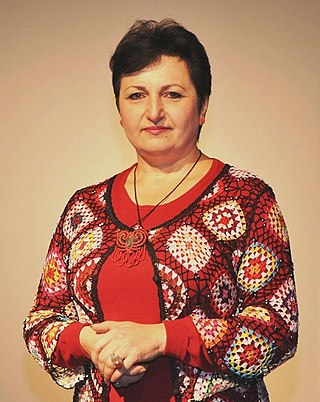
The komuz or qomuz is an ancient fretless string instrument used in Central Asian music, related to certain other Turkic string instruments, the Mongolian tovshuur, and the lute. The instrument can be found in Turkic ethnic groups, from China to Turkey. Forms of this instrument are used in China by the Naxi people and are called Huobusi, Hebisi , and Hunbusi.

Azerbaijani literature is written in Azerbaijani, a Turkic language, which is the official state language of the Republic of Azerbaijan, where the North Azerbaijani variety is spoken. It is also natively spoken in Iran, where the South Azerbaijani variety is used, and is particularly spoken in the northwestern historic region of Azerbaijan. Azerbaijani is also spoken natively in Russia, Georgia and Turkey. While the majority of Azerbaijani people live in Iran, modern Azerbaijani literature is overwhelmingly produced in the Republic of Azerbaijan, where the language has official status. Three scripts are used for writing the language: Azerbaijani Latin script in the Republic of Azerbaijan, Arabic script in Iran and Cyrillic script formerly used in Soviet Azerbaijan.
The culture of Azerbaijan combines a diverse and heterogeneous set of elements which developed under the influence of Iranic, Turkic and Caucasian cultures. Azerbaijani culture includes its cuisine, literature, folk art, and music.

The Book of Dede Korkut or Book of Korkut Ata is the most famous among the dastans or epic stories of the Oghuz Turks. The stories carry morals and values significant to the social lifestyle of the nomadic Turkic peoples and their pre-Islamic beliefs. The book's mythic narrative is part of the cultural heritage of the peoples of Oghuz origin, mainly of Azerbaijan, Turkey and Turkmenistan. Only two manuscripts of the text, one in the Vatican and one in Dresden, were known before a third manuscript was discovered in a private collection in Gonbad-e Kavus, Iran, in 2018.

An ashik or ashugh is traditionally a singer-poet and bard who accompanies his song—be it a dastan or a shorter original composition—with a long-necked lute in Azerbaijani culture, including Turkish and South Azerbaijani and non-Turkic cultures of South Caucasus. In Azerbaijan, the modern ashik is a professional musician who usually serves an apprenticeship, masters playing the bağlama, and builds up a varied but individual repertoire of Turkic folk songs.

Turkic mythology refers to myths and legends told by the Turkic people. It features Tengrist and Shamanist strata of belief along with many other social and cultural constructs related to the nomadic and warrior way of life of Turkic and Mongol peoples in ancient times. Turkic mythology shares numerous ideas and practices with Mongol mythology. Turkic mythology has also been influenced by other local Asiatic and Eurasian mythologies. For example, in Tatar mythology elements of Finnic and Indo-European mythologies co-exist. Beings from Tatar mythology include Äbädä, Alara, Şüräle, Şekä, Pitsen, Tulpar, and Zilant.

Azerbaijan National Academy of Sciences (ANAS), located in Baku, is the main state research organization and the primary body that conducts research and coordinates activities in the fields of science and social sciences in Azerbaijan. It was established on 23 January 1945.
Azerbaijani folklore is the folk tradition of Azerbaijani people.

Azerbaijani fairy tales are works of folklore by the Azerbaijani people. They vary in context and subject and include tales from the heroic past of the Azerbaijani people and struggles with local and foreign oppressors. Spiritual, moral, social and philosophical views are reflected throughout these tales.

Hamid Mammadtaghi oglu Arasly was an Azerbaijani literary critic, Doctor of Sciences in Philology, and an academic at the Azerbaijan National Academy of Sciences. He is acknowledged as one of the most prominent literary critics and philologists of Azerbaijan.

Salman Mumtaz — Azerbaijani poet, literature historian, bibliographer, and collector of medieval manuscripts. He was a member of the Union of Azerbaijani writers since 1934, a researcher in the 1st category of the literature sector of the Azerbaijani Branch of the Academy of Sciences of the Soviet Union, and the director of the Azerbaijani Literature Department of the Azerbaijani National Institute of Scientific Research from 1929 to 1932. Salman Mumtaz was a renowned Azerbaijani literary scholar and poet. He was born in Shaki in 1884. In his efforts to collect, publish and promote the classical literary legacy, he discovered unknown manuscripts of a number of Azerbaijani poets and ashugs. Falling a victim to repressions, he was arrested in 1937 and killed by shooting in 1941 while imprisoned in Oryol.

Gullu Yologlu is an Azerbaijani academic and the chairperson of the World Turkology Center. They have contributed ethnology, folklore studies, literature, history, religious studies and other scientific fields in Azerbaijan by providing information, analysis and outcomes with her scholarly and scholarly-publicistic articles and books, and her scientific and artistic radio and television programs since the 1990s. Her main research areas are faiths, traditions, ethnic identities, shamanist past, material and non-material culture of small-numbered Turkic peoples living in countries from the Siberia to the Balkans.

Irada Rovshan was an Azerbaijan architect and scientist. She was head of the “Folklore and Ethnography” laboratory of Sheki Regional Scientific Center, and a member of the Union of Architects of Azerbaijan.
The ANAS Central Library of Science was founded in 1923 in Baku, Azerbaijan.
Azerbaijani libraries are divided into 2 parts: state and non-state. State libraries are National Library, State Library of the Autonomous Republic of Nakhchivan; city, rayon, town libraries; republican scientific and cultural libraries; libraries of the state, government, enterprises and organizations; the Central Scientific Library of the Academy of Sciences of Azerbaijan and its branches. Non-state libraries are municipal libraries, libraries of public associations, private and other libraries of foreign legal entities and individuals, libraries created in accordance with the law.
Turkmen literature comprises oral compositions and written texts in the Old Oghuz Turkic and Turkmen languages. The Turkmens are direct descendants of the Oghuz Turks, who were a western Turkic people, who formed the Oghuz branch of the Turkic language family.

Bamsi Beyrek is a character in the Book of Dede Korkut and in Turkish, Azeri and some Altai legends. Despite his stories being far-stretched, it is believed that he may have indeed been a real person.
Institute of Linguistics named after Nasimi is one of the institutes of the Department of Humanities and Social Sciences of the National Academy of Sciences of Azerbaijan.
Arif Acaloğlu was an Azerbaijani-Turkish folklorist, Turkologist, anthropologist, translator, and former advisor to the president of Azerbaijan.











